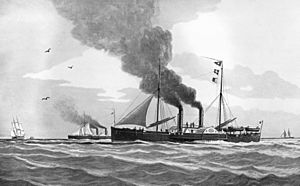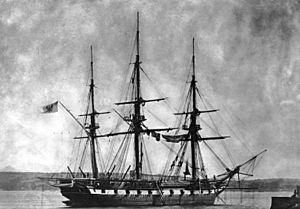SMS Nix facts for kids

1905 painting of Nix and Salamander by Lüder Arenhold
|
|
Quick facts for kids History |
|
|---|---|
| Name | Nix |
| Namesake | Nix |
| Builder | Robinson & Russell |
| Laid down | 1850 |
| Launched | 1850 |
| Commissioned | 29 July 1851 |
| Fate | Sold to Britain, 12 January 1855 |
| Name | Weser |
| Acquired | 12 January 1855 |
| Decommissioned | 1865 |
| Fate | Sold, 29 October 1873, broken up |
| General characteristics | |
| Class and type | Nix-class aviso |
| Displacement | |
| Length | 53.85 m (176 ft 8 in) o/a |
| Beam |
|
| Draft | 2 m (6 ft 7 in) |
| Installed power | |
| Propulsion |
|
| Speed | 13 kn (24 km/h; 15 mph) |
| Range | 2,500 nmi (4,600 km; 2,900 mi) at 10 kn (19 km/h; 12 mph) |
| Complement |
|
| Armament | 4 × 25-pound mortars |
SMS Nix was a special type of ship called an aviso. It was the first of two ships in its class built for the Prussian Navy in the early 1850s. After it was finished in 1851, Nix didn't do much, mostly short training trips in the Baltic Sea.
These trips often had problems, like the ship's boilers catching fire. Because of these issues, the Prussian Navy decided to sell both ships in the Nix class. In 1855, Prussia sold Nix to the British Royal Navy. In return, they received a sailing ship called Thetis.
The British renamed the ship HMS Weser. It took part in the Crimean War during the Battle of Kinburn in October 1855. After the war, it was mostly based in Malta and didn't see much action. The ship was officially taken out of service in 1865. It was then used as a harbor ship before being sold for scrap in 1873.
Contents
Ship Design and Features
The Nix-class avisos were paddle steamers. This means they used large wheels on the sides to move through the water, powered by steam engines. These ships were designed in 1849 by a British naval expert, John Scott Russell, and Prince Adalbert.
They were ordered in 1850 to make the small Prussian Navy stronger during the First Schleswig War. The ships were built by Russell's company, Robinson & Russell.
Size and Structure
Nix was about 53.85 m (176 ft 8 in) long from front to back. Its beam, or width, was 7.2 m (23 ft 7 in) across the main body of the ship. However, it was wider at 12.4 m (40 ft 8 in) when measured across its large paddle wheels.
When fully loaded, the ship weighed about 430 t (420 long tons). Its draft, which is how deep the ship sits in the water, was 2 m (6 ft 7 in).
Engine and Speed
The ship had two steam engines that powered the paddle wheels. These engines got their steam from four large boilers. The smoke from the boilers went out through two tall funnels.
The engines could produce 600 PS (592 ihp) of power. This allowed Nix to reach a top speed of 13 knots (24 km/h; 15 mph) (knots). A knot is a unit of speed used for ships, equal to about 1.15 miles per hour.
Range and Crew
At a slower speed of 10 knots (19 km/h; 12 mph), the ship could travel for 2,500 nautical miles (4,600 km; 2,900 mi) (nautical miles) without needing to refuel. A nautical mile is slightly longer than a regular mile.
The crew on board Nix usually included four officers and about seventy other sailors.
Weapons
For defense, the ship carried four 25-pound mortars. Mortars are a type of cannon that fire shells in a high arc.
Ship's Journey and Service
Nix began construction in 1850 and was launched later that year. The builders wanted to finish the ship before winter, when Prussia's Baltic harbors would freeze. However, delays meant they had to slow down work on Nix to focus on its sister ship, Salamander.
Early Prussian Service
In March 1851, the ship's first commander and crew went to London. They trained during the ship's first trips to test it out. Since the Prussian Navy didn't have many experienced engineers, a British expert was hired to oversee the ship's engine room.
Nix left London in mid-April to sail to Prussia. But the crew was new, and one of the boilers caught fire, while another started leaking. As the ship entered the Oder river, it got stuck because of a mistake by the pilot. Salamander arrived and helped pull it free.
Nix then went to the naval base in Stettin for repairs. During this time, the crew continued their training, and the ship's guns were installed. Nix was officially put into service on July 29. It was named after the nix, a water spirit from German folklore.
After joining the fleet, Nix took part in training exercises. Prince Adalbert himself came aboard for a trip to Danzig. By late August, another ship, the frigate Mercur, joined it in Danzig Bay. Nix later carried Prince Karl of Prussia to Kronstadt, in Russia.
These early operations often had problems, especially boiler fires. These fires were linked to the wooden areas around the boilers. By September, the ship was in Stralsund and was taken out of service. In 1852, the ship didn't do much, except carrying King Friedrich Wilhelm IV between Stralsund, Putbus, and Danzig. It also went to Karlskrona, Sweden, for repairs that year. It stayed out of service for all of 1853.
In May 1854, it was put back into service. On June 26, it carried soldiers from the naval battalion from Stettin to Danzig. King Friedrich Wilhelm IV and Prince Karl boarded the ship again in July for a visit to Kronstadt, which ended in September. After that, Nix had more repairs in Danzig.
Sale to Britain
The ships in the Nix class had a bad reputation, mainly because of the repeated fires. So, the Prussian Navy decided to sell them. They first tried to trade them for two small ships called corvettes from the British Royal Navy.
After talks, an agreement was made in late 1854. The British needed small, fast steamships for the Crimean War. So, Prussia traded Nix and Salamander for the sailing frigate Thetis.
In early November, Nix and Salamander left Danzig. On November 23, they stopped in Jade Bay to celebrate the opening of the naval base at Wilhelmshaven. Two days later, they continued their journey to Britain.
However, the government of Hannover at first didn't let them enter Bremen on the Weser river. They needed to get coal for the trip across the North Sea and shelter from bad weather. After pressure from Prussia, they were finally allowed in on December 1.
They stayed there until December 11. But a severe storm kept them from leaving the Weser estuary for three more days. During the journey, more storms caused the two ships to get separated. Nix arrived in Devonport on December 19. On January 12, 1855, the ship was officially given to British control.
British Service as HMS Weser

The Royal Navy renamed the ship Weser. It was sent to the Devonport shipyard for a major check-up. After that, it was sent to the Mediterranean Sea in March. Its commander at the time was John Edmund Commerell.
While operating in the Black Sea, Weser again caught fire near Constantinople. Commander Commerell quickly ran the ship aground to help put out the fire. After the fire was stopped, the ship was pulled free. It later joined the siege of Sevastopol in June.
On the night of June 16, Weser joined several other ships to bombard Russian positions defending the city. Weser later entered the Sea of Azov. On October 11, Commander Commerell, William Thomas Rickard (the ship's quartermaster), and a sailor went ashore to burn Russian supplies. Both Commerell and Rickard were given the Victoria Cross for their brave actions.
The ship then joined the fleet that attacked Kinburn on October 17. This attack led to the Battle of Kinburn.
After the war, Weser was stationed in Malta. In early 1859, it returned to Britain for a big overhaul at the Woolwich Arsenal. This work took place between May 1, 1859, and May 1861. After that, it went back to the Mediterranean.
The ship was taken out of service in Malta in 1865. It was then used as a harbor ship until 1873. On October 29, 1873, it was sold for scrap and taken apart.


